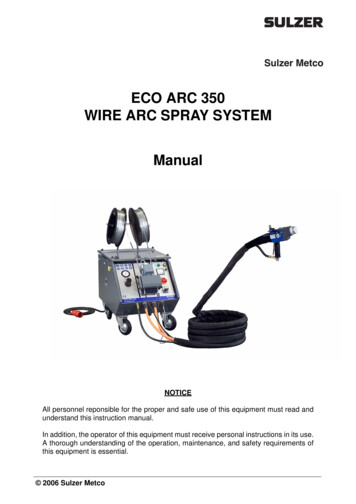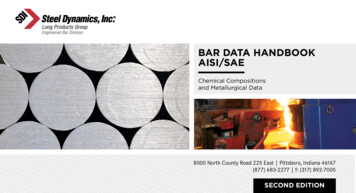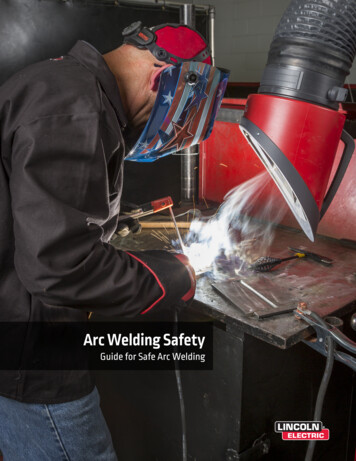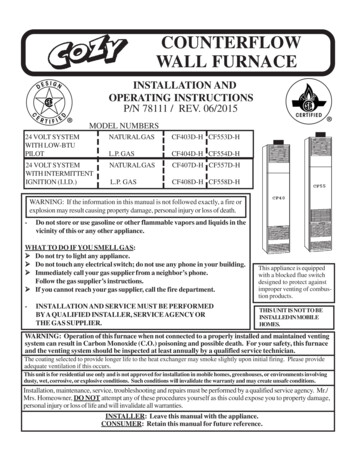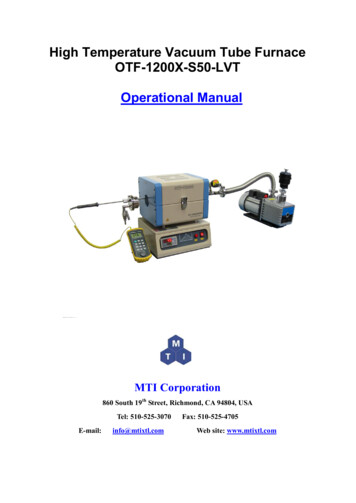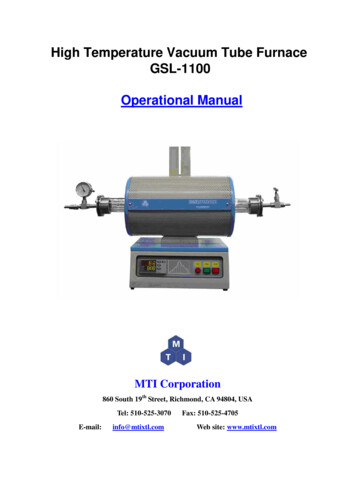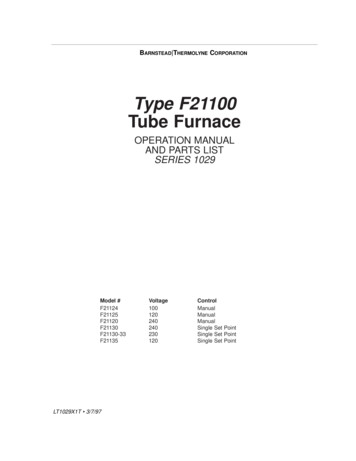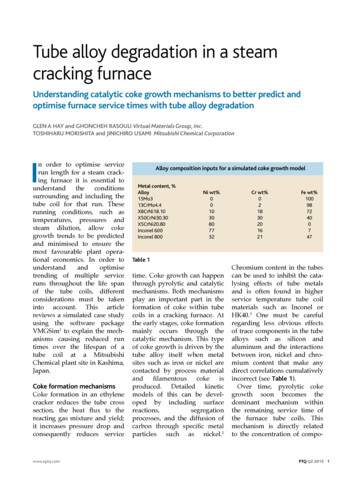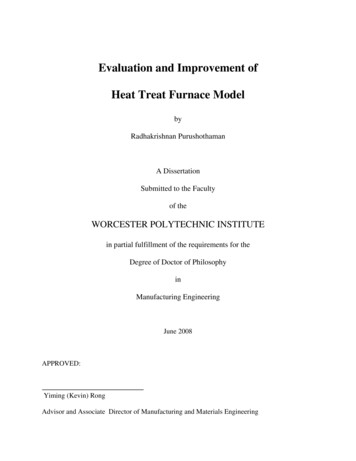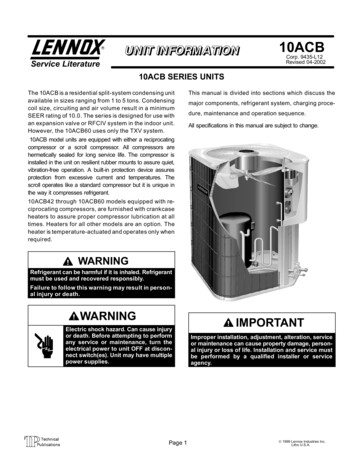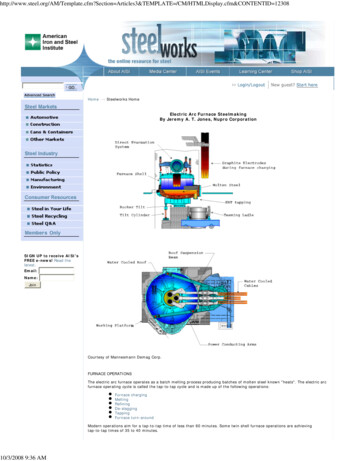
Transcription
http://www.steel.org/AM/Template.cfm?Section Articles3&TEMPLATE /CM/HTMLDisplay.cfm&CONTENTID 12308HomeSteelworks HomeElectric Arc Furnace SteelmakingBy Jeremy A. T. Jones, Nupro CorporationSIGN UP to receive AISI'sFREE e-news! Read thelatest.Email:Name:Join10/3/2008 9:36 AMCourtesy of Mannesmann Demag Corp.FURNACE OPERATIONSThe electric arc furnace operates as a batch melting process producing batches of molten steel known "heats". The electric arcfurnace operating cycle is called the tap-to-tap cycle and is made up of the following operations:Furnace chargingMeltingRefiningDe-slaggingTappingFurnace turn-aroundModern operations aim for a tap-to-tap time of less than 60 minutes. Some twin shell furnace operations are achievingtap-to-tap times of 35 to 40 minutes.
http://www.steel.org/AM/Template.cfm?Section Articles3&TEMPLATE /CM/HTMLDisplay.cfm&CONTENTID 1230810/3/2008 9:36 AMFurnace ChargingThe first step in the production of any heat is to select the grade of steel to be made. Usually a schedule is developed prior toeach production shift. Thus the melter will know in advance the schedule for his shift. The scrap yard operator will preparebuckets of scrap according to the needs of the melter. Preparation of the charge bucket is an important operation, not only toensure proper melt-in chemistry but also to ensure good melting conditions. The scrap must be layered in the bucketaccording to size and density to promote the rapid formation of a liquid pool of steel in the hearth while providing protectionfor the sidewalls and roof from electric arc radiation. Other considerations include minimization of scrap cave-ins which canbreak electrodes and ensuring that large heavy pieces of scrap do not lie directly in front of burner ports which would result inblow-back of the flame onto the water cooled panels. The charge can include lime and carbon or these can be injected into thefurnace during the heat. Many operations add some lime and carbon in the scrap bucket and supplement this with injection.The first step in any tap-to-tap cycle is "charging" into the scrap. The roof and electrodes are raised and are swung to the sideof the furnace to allow the scrap charging crane to move a full bucket of scrap into place over the furnace. The bucket bottomis usually a clam shell design - i.e. the bucket opens up by retracting two segments on the bottom of the bucket. The scrapfalls into the furnace and the scrap crane removes the scrap bucket. The roof and electrodes swing back into place over thefurnace. The roof is lowered and then the electrodes are lowered to strike an arc on the scrap. This commences the meltingportion of the cycle. The number of charge buckets of scrap required to produce a heat of steel is dependent primarily on thevolume of the furnace and the scrap density. Most modern furnaces are designed to operate with a minimum of back-charges.This is advantageous because charging is a dead-time where the furnace does not have power on and therefore is not melting.Minimizing these dead-times helps to maximize the productivity of the furnace. In addition, energy is lost every time thefurnace roof is opened. This can amount to 10 - 20 kWh/ton for each occurrence. Most operations aim for 2 to 3 buckets ofscrap per heat and will attempt to blend their scrap to meet this requirement. Some operations achieve a single bucketcharge. Continuous charging operations such as CONSTEEL and the Fuchs Shaft Furnace eliminate the charging cycle.TopMeltingThe melting period is the heart of EAF operations. The EAF has evolved into a highly efficient melting apparatus and moderndesigns are focused on maximizing the melting capacity of the EAF. Melting is accomplished by supplying energy to thefurnace interior. This energy can be electrical or chemical. Electrical energy is supplied via the graphite electrodes and isusually the largest contributor in melting operations. Initially, an intermediate voltage tap is selected until the electrodes boreinto the scrap. Usually, light scrap is placed on top of the charge to accelerate bore-in. Approximately 15 % of the scrap ismelted during the initial bore-in period. After a few minutes, the electrodes will have penetrated the scrap sufficiently so thata long arc (high voltage) tap can be used without fear of radiation damage to the roof. The long arc maximizes the transfer ofpower to the scrap and a liquid pool of metal will form in the furnace hearth At the start of melting the arc is erratic andunstable. Wide swings in current are observed accompanied by rapid movement of the electrodes. As the furnace atmosphereheats up the arc stabilizes and once the molten pool is formed, the arc becomes quite stable and the average power inputincreases.Chemical energy is be supplied via several sources including oxy-fuel burners and oxygen lances. Oxy-fuel burners burnnatural gas using oxygen or a blend of oxygen and air. Heat is transferred to the scrap by flame radiation and convection bythe hot products of combustion. Heat is transferred within the scrap by conduction. Large pieces of scrap take longer to meltinto the bath than smaller pieces. In some operations, oxygen is injected via a consumable pipe lance to "cut" the scrap. Theoxygen reacts with the hot scrap and burns iron to produce intense heat for cutting the scrap. Once a molten pool of steel isgenerated in the furnace, oxygen can be lanced directly into the bath. This oxygen will react with several components in thebath including, aluminum, silicon, manganese, phosphorus, carbon and iron. All of these reactions are exothermic (i.e. theygenerate heat) and supply additional energy to aid in the melting of the scrap. The metallic oxides that are formed will end upin the slag. The reaction of oxygen with carbon in the bath produces carbon monoxide, which either burns in the furnace ifthere is sufficient oxygen, and/or is exhausted through the direct evacuation system where it is burned and conveyed to thepollution control system. Auxiliary fuel operations are discussed in more detail in the section on EAF operations.Once enough scrap has been melted to accommodate the second charge, the charging process is repeated. Once the finalscrap charge is melted, the furnace sidewalls are exposed to intense radiation from the arc. As a result, the voltage must bereduced. Alternatively, creation of a foamy slag will allow the arc to be buried and will protect the furnace shell. In addition, agreater amount of energy will be retained in the slag and is transferred to the bath resulting in greater energy efficiency.Once the final scrap charge is fully melted, flat bath conditions are reached. At this point, a bath temperature and sample willbe taken. The analysis of the bath chemistry will allow the melter to determine the amount of oxygen to be blown duringrefining. At this point, the melter can also start to arrange for the bulk tap alloy additions to be made. These quantities arefinalized after the refining period.Top Next PageAbout Search Site Map Contact Shop Privacy PolicyCopyright 2008, American Iron and Steel Institute
http://www.steel.org/AM/Template.cfm?Section Articles3&CONTENTID 21169&TEMPLATE /CM/HTMLDisplay.cfmHomeSteelworks HomeElectric Arc Furnace SteelmakingBy Jeremy A. T. Jones, Nupro CorporationcontinuedFurnace chargingMeltingRefiningDe-slaggingTappingFurnace turn-aroundTopRefiningRefining operations in the electric arc furnace have traditionally involved the removal of phosphorus, sulfur, aluminum, silicon,manganese and carbon from the steel. In recent times, dissolved gases, especially hydrogen and nitrogen, been recognized asa concern. Traditionally, refining operations were carried out following meltdown i.e. once a flat bath was achieved. Theserefining reactions are all dependent on the availability of oxygen. Oxygen was lanced at the end of meltdown to lower the bathcarbon content to the desired level for tapping. Most of the compounds which are to be removed during refining have a higheraffinity for oxygen that the carbon. Thus the oxygen will preferentially react with these elements to form oxides which float outof the steel and into the slag.In modern EAF operations, especially those operating with a "hot heel" of molten steel and slag retained from the prior heat,oxygen may be blown into the bath throughout most of the heat. As a result, some of the melting and refining operationsoccur simultaneously.SIGN UP to receive AISI'sFREE e-news! Read thelatest.Email:Name:Join10/3/2008 9:35 AMPhosphorus and sulfur occur normally in the furnace charge in higher concentrations than are generally permitted in steel andmust be removed. Unfortunately the conditions favorable for removing phosphorus are the opposite of those promoting theremoval of sulfur. Therefore once these materials are pushed into the slag phase they may revert back into the steel.Phosphorus retention in the slag is a function of the bath temperature, the slag basicity and FeO levels in the slag. At highertemperature or low FeO levels, the phosphorus will revert from the slag back into the bath. Phosphorus removal is usuallycarried out as early as possible in the heat. Hot heel practice is very beneficial for phosphorus removal because oxygen can belanced into the bath while its temperature is quite low. Early in the heat the slag will contain high FeO levels carried over fromthe previous heat thus aiding in phosphorus removal. High slag basicity (i.e. high lime content) is also beneficial forphosphorus removal but care must be taken not to saturate the slag with lime. This will lead to an increase in slag viscosity,which will make the slag less effective. Sometimes fluorspar is added to help fluidize the slag. Stirring the bath with inert gasis also beneficial because it renews the slag/metal interface thus improving the reaction kinetics.In general, if low phosphorus levels are a requirement for a particular steel grade, the scrap is selected to give a low level atmelt-in. The partition of phosphorus in the slag to phosphorus in the bath ranges from 5 to 15. Usually the phosphorus isreduced by 20 to 50 % in the EAF.Sulfur is removed mainly as a sulfide dissolved in the slag. The sulfur partition between the slag and metal is dependent onslag chemistry and is favored at low steel oxidation levels. Removal of sulfur in the EAF is difficult especially given modernpractices where the oxidation level of the bath is quite high. Generally the partition ratio is between 3 and 5 for EAFoperations. Most operations find it more effective to carry out desulfurization during the reducing phase of steelmaking. Thismeans that desulfurization is performed during tapping (where a calcium aluminate slag is built) and during ladle furnaceoperations. For reducing conditions where the bath has a much lower oxygen activity, distribution ratios for sulfur of between20 and 100 can be achieved.Control of the metallic constituents in the bath is important as it determines the properties of the final product. Usually, themelter will aim at lower levels in the bath than are specified for the final product. Oxygen reacts with aluminum, silicon andmanganese to form metallic oxides, which are slag components. These metallics tend to react with oxygen before the carbon.They will also react with FeO resulting in a recovery of iron units to the bath. For example:Mn FeO MnO FeManganese will typically be lowered to about 0.06 % in the bath.The reaction of carbon with oxygen in the bath to produce CO is important as it supplies a less expensive form of energy to thebath, and performs several important refining reactions. In modern EAF operations, the combination of oxygen with carbon cansupply between 30 and 40 % of the net heat input to the furnace. Evolution of carbon monoxide is very important for slagfoaming. Coupled with a basic slag, CO bubbles are tapped in the slag causing it to "foam" and helping to bury the arc. Thisgives greatly improved thermal efficiency and allows the furnace to operate at high arc voltages even after a flat bath has beenachieved. Burying the arc also helps to prevent nitrogen from being exposed to the arc where it can dissociate and enter intothe steel.If the CO is evolved within the steel bath, it helps to strip nitrogen and hydrogen from the steel. Nitrogen levels in steel as lowas 50 ppm can be achieved in the furnace prior to tap. Bottom tapping is beneficial for maintaining low nitrogen levels becausetapping is fast and a tight tap stream is maintained. A high oxygen potential in the steel is beneficial for low nitrogen levelsand the heat should be tapped open as opposed to blocking the heat.
http://www.steel.org/AM/Template.cfm?Section Articles3&CONTENTID 21169&TEMPLATE /CM/HTMLDisplay.cfm10/3/2008 9:35 AMAt 1600 C, the maximum solubility of nitrogen in pure iron is 450 ppm. Typically, the nitrogen levels in the steel followingtapping are 80 - 100 ppm.Decarburization is also beneficial for the removal of hydrogen. It has been demonstarted that decarburizing at a rate of 1 %per hour can lower hydrogen levels in the steel from 8 ppm down to 2 ppm in 10 minutes.At the end of refining, a bath temperature measurement and a bath sample are taken. If the temperature is too low, powermay be applied to the bath. This is not a big concern in modern meltshops where temperature adjustment is carried out in theladle furnace.TopDe-SlaggingDe-slagging operations are carried out to remove impurities from the furnace. During melting and refining operations, some ofthe undesirable materials within the bath are oxidized and enter the slag phase.It is advantageous to remove as much phosphorus into the slag as early in the heat as possible (i.e. while the bathtemperature is still low). The furnace is tilted backwards and slag is poured out of the furnace through the slag door. Removalof the slag eliminates the possibility of phosphorus reversion.During slag foaming operations
By Jeremy A. T. Jones, Nupro Corporation Courtesy of Mannesmann Demag Corp. FURNACE OPERATIONS The electric arc furnace operates as a batch melting process producing batches of molten steel known "heats". The electric arc furnace operating cycle is called the tap-to-tap cycle and is made up of the following operations: Furnace charging Melting Refining De-slagging Tapping Furnace
